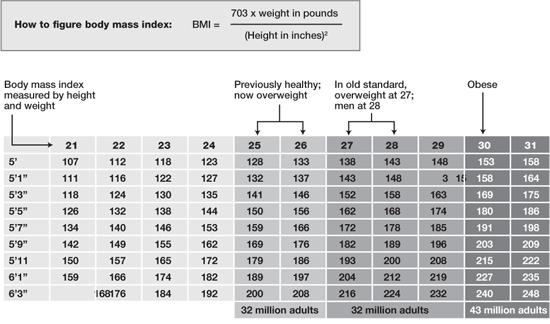BMI Calculator
Introduction
Body Mass Index (BMI) is a ratio of your height and weight. Knowing your
BMI is a good start to determining whether you are overweight or not.
Previously a BMI of > 27 was considered too high. More recently, that
number was revised down to 25.
Using this newer, more aggressive definition of over-weight, over 100
million Americans are overweight and probably 10 million Canadians fall
into this category. This epidemic of obesity starts in childhood and contributes
in large measure to the development of hypertension, heart disease, stroke
and diabetes.
In order to achieve a BMI that is appropriate to our height we must all
modify our lifestyle and eating habits. Adequate rest and physical activity
are necessary partners
to a healthy diet in achieving weight reduction.
Re-Calculating a Hefty Sum
The U.S. government’s new standard, based on “body mass index,”
increases the number of North American adults defined as overweight.

How to calculate your Body Mass Index
Body Mass Index (BMI) is a ratio of height and weight. On this chart,
the numbers across the top are the BMI. Heights are show on the left,
and the numbers making up the box are weights in pounds. To find your
BMI, find your height, then look across to the box with the appropriate
height. The number at the top of that column is your BMI.
You can call the Ottawa-Carleton Regional Health Department's nutrition
line
at 722-2242 ext 3403 to obtain a Health Canada BMI chart, or you can
calculate your BMI by visiting an the NHLBI Website at
http://www.nhlbisupport.com/bmi/bmicalc.htm
How to calculate your waist-to-hip ratio
- Measure your waist at your navel (In inches or centimeters).
- Measure your hips at the widest point (over your buttocks).
- Divide your waist measurement by your hip measurement.
For example: if you have a 27 inch waist and 38-inch hips, divide 27
by 38 to get a waist hip ratio of 0.71. For most women, the waist-to-hip
ratio should fall below 0.80. For most men, the waist to hip ratio should
be no greater than 1.0
|

